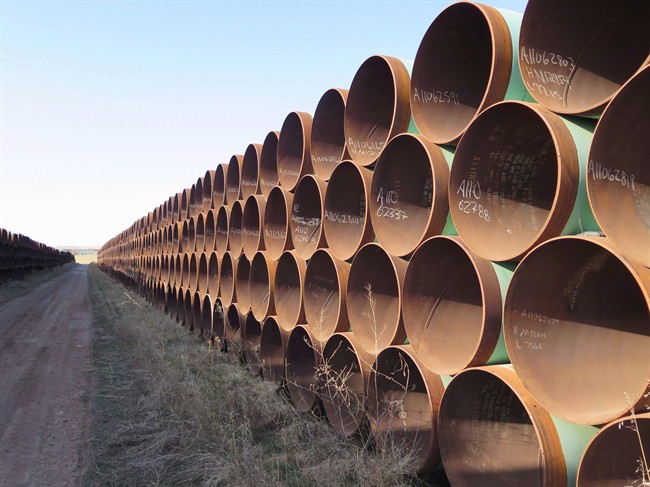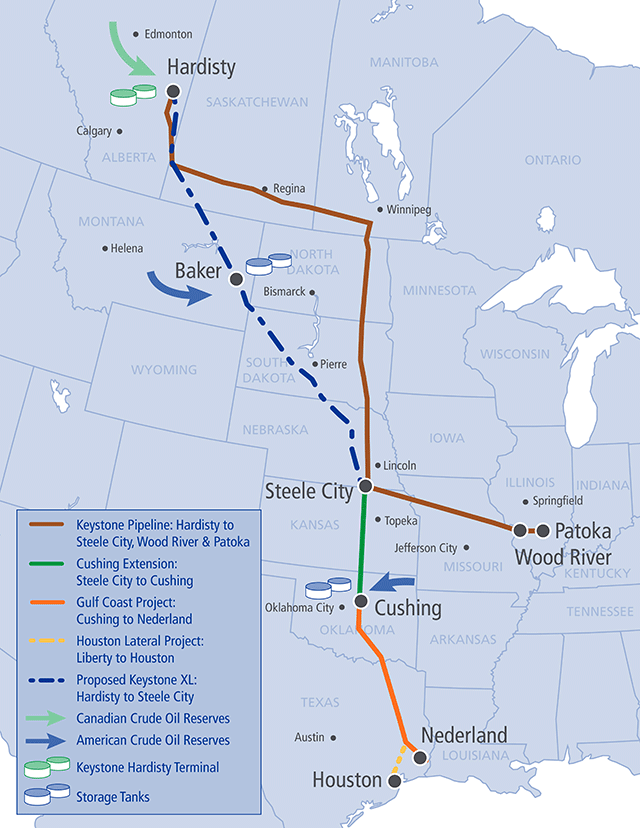The Obama administration has rejected TransCanada’s application to build the Keystone XL pipeline that would connect Canada’s oilsands to Gulf Coast refineries.

Here are some key dates in the history of the pipeline proposal:
July 2008: TransCanada Corp. (TSX:TRP) and ConocoPhillips, joint owners of the Keystone Pipeline, propose a major extension to the network, dubbed Keystone XL. The new addition is proposed to transport hundreds of thousands of barrels of oilsands bitumen from Alberta to Texas. TransCanada files an official application for permission to build the project months later and environmental groups start voicing objections.
2009: As the U.S. State Department wades through comments based on an environmental assessment of the project, TransCanada starts visiting landowners potentially affected by the pipeline project. Opposition to the project emerges in Nebraska.
June 2009: TransCanada announces it will buy the stake that ConocoPhillips has in Keystone.
March 2010: The National Energy Board approves TransCanada’s application for Keystone XL, though the green light comes with 22 conditions regarding safety, environmental protection and landowner rights.
April 2010: The U.S. State Department releases a draft environmental impact statement saying Keystone XL would have a limited effect on the environment.
June-July 2010: Opposition to Keystone XL begins mounting in the United States. Legislators write a letter to Secretary of State Hillary Clinton calling for greater environmental oversight; scientists begin speaking out against the project; and the Environmental Protection Agency questions the need for the pipeline extension.
July 2010: The State Department extends its review of Keystone, saying federal agencies need more time to weigh in before a final environmental impact assessment can be released.
March 2011: The State Department announces a further delay in its environmental assessment.
Aug. 26, 2011: The State Department releases its final environmental assessment, which reiterates its findings from 2010.
August-September 2011: Protesters stage a two-week campaign of civil disobedience at the White House to speak out against Keystone XL. Police arrest approximately a thousand people, including actors Margot Kidder and Daryl Hannah as well as Canadian activist Naomi Klein.
Sept. 26, 2011: At a demonstration on Parliament Hill, police arrest 117 of the 400 protesters on hand.
Nov. 10, 2011: The State Department says TransCanada must reroute Keystone XL to avoid an ecologically sensitive region of Nebraska. Environmental protesters had decried the pipeline for traversing the state’s Ogallala Aquifer, a source of drinking water to millions on the Great Plains.
Nov. 14, 2011: TransCanada says it will comply with State Department demands and reroute the pipeline.
December 2011: U.S. legislators pass a bill that contains a provision related to Keystone XL. The provision states that President Barack Obama must make a decision on the pipeline’s future in the next 60 days.
Jan. 18, 2012: Obama rejects Keystone XL, saying the timeline imposed by the December bill did not leave enough time to review the new route. Obama said TransCanada was free to submit another application.
READ MORE: Don’t ask for Keystone XL timeline, White House tells Canada
Feb. 27, 2012: TransCanada says it will build the southern leg of Keystone XL, which runs from Cushing, Okla. to the Gulf Coast, as a separate project with a price tag of $2.3 billion. The southern portion of the pipeline was not subject to presidential permission, since it did not cross an international border.
April 18, 2012: TransCanada submits a new route to officials in Nebraska for approval.
May 4, 2012: TransCanada files a new application with the State Department for the northern part of Keystone XL.
Jan. 22, 2013: Nebraska Gov. Dave Heineman approves TransCanada’s proposed new route for Keystone XL, sending the project back to the State Department for review.
January 2013: Pipeline opponents file a lawsuit against the Nebraska government claiming the state law used to review the new route is unconstitutional because it doesn’t allow for judicial review or spell out what criteria should be considered when evaluating a pipeline project. The Nebraska government contested the suit.
Jan. 31, 2014: The State Department says in a report that Keystone XL would produce fewer greenhouse gas emissions than transporting oil to the Gulf of Mexico by rail.
READ MORE: New report raises no major objections to Keystone XL pipeline
Feb. 19, 2014: A Nebraska judge ruled that the law that allowed the state governor to approve Keystone XL over the objections of landowners was unconstitutional. Nebraska said it would appeal the ruling.
April 18, 2014: The State Department suspends the regulatory process indefinitely, citing uncertainty about the court case in Nebraska.
Nov. 4, 2014: TransCanada says the costs of Keystone XL have grown from US$5.4 billion to US$8 billion.
November-December 2014: Midterm elections turn control of the U.S. Congress over to Republicans, who say they’ll make acceptance of Keystone XL a top priority. But Obama adopts an increasingly negative tone on the issue.
Jan. 9, 2015: At Nebraska Supreme Court, by the narrowest of margins, a panel of seven judges strikes down a lower-court decision that a state law approving the pipeline route was adopted by unconstitutional methods.
READ MORE: Alberta Premier says Nebraska court ruling clears path for approval of Keystone XL pipeline
Jan. 29, 2015: The U.S. Senate approves a bill to build Keystone XL, but the victory is expected to be short-lived as the White House has signalled that Obama plans to veto the bill when it lands on his desk.
Feb. 24, 2015: Obama vetoes the bill that would have approved construction of the Keystone XL oil pipeline.
READ MORE: New report says pipelines are safer than rail
June 30, 2015: TransCanada sends a letter to Secretary of State John Kerry and other U.S. officials saying the State Department should include recent climate change policy announcements by the Alberta and federal governments in its review of Keystone XL.
Nov. 2, 2015: TransCanada asks the U.S. government to temporarily suspend its application.
Nov. 4, 2015: The U.S. government rejects that request.
READ MORE: Hardisty mayor says Keystone not only game in town
Nov. 6, 2015: The Obama administration rejects TransCanada’s application to build the Keystone XL pipeline. TransCanada CEO Russ Girling says he is disappointed with the decision but continues to believe the project is in the best interests of both Canada and the U.S.




Comments